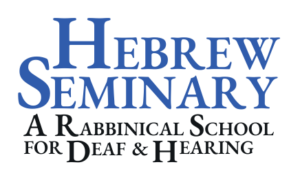The Return of the Horn: Commentary for Rosh HaShanah 5783
By: Rabbi Jonah Rank, Hebrew Seminary President & Rosh Yeshivah
Whether or not we will feel ready, we will soon proclaim the new Jewish year with the blast of a ram’s horn[1]—and we are supposed to feel sheepish.
Se’adiah Ga’on, who led the Jews of Sura (in modern-day Iraq) from 928 until his death in 942,[2] associated sheep with feeling humbled. This Babylonian Jewish sage wrote a lengthy composition that directed its readers to the Hebrew prayers he deemed most fitting for the different days of the Jewish year.[3] His כתאב ג׳אמע אלצלואת ואלתסאביח (Kitāb Jāmi` aṣ-Ṣalawāt wat-Tasābiḥ, “The Comprehensive Book of Prayers and Praises”) in Judeo-Arabic was among the most influential medieval guides to Jewish worship.[4] In the section he devoted to the Hebrew prayers to recite on Rosh HaShanah, Se’adiah critiqued the many holiday-themed poems that had been composed but were, in his mind, undeserving of publication.[5] Se’adiah however looked into the past and recommended that communities recite a few poetic insertions from Yose ben Yose, a פַּיְּטָן (payyetan, ‘Jewish-prayer-poet’) who lived nearly 500 years before Se’adyah.[6]
The ancient poet imagined himself praying to God from the perspective of a whole different species:
בַּקּֽרֵֽנִי; דָרְשֵֽׁנִי; שֶֹה פְזוּרָה אָנִֽי. נִגְזַֽזְתִּי וְנֶאֱלַֽמְתִּי, בְּלִי לְהָרִים קוֹל
בֶּאֱמוֹר גּוֹזְזַי, ״נִדָּחָה הִיא; שׁוֹמְרָהּ וְצִלָּהּ לֹא יִשְׁאַג בְּקוֹל.״[7]
Shepherd me[8]; seek me; a scattered sheep am I. I have been shorn, and I have been muted, so as not to raise a voice
When those who shear me say, “She is forsaken; her Guardian, nay her Protector, shall not roar a voice.”[9]
Se’adyah includes this פִּיּוּט (piyyut, ‘prayer-poem’) during the שׁוֹפָרוֹת (Shofarot, “Ram-horns”) service on Rosh HaShanah morning. In transforming the supplicant into a sheep during this moment of prayer, the payyetan personalizes the שׁוֹפָר (shofar, “ram horn”). The shofar is no longer a horn that came from some other animal. The horn may be our own—or, more properly, it may have once been our own. Somewhere along the way, we lost that appendage. If only we could raise our voice and make a sound—if only taking hold of the shofar were all it would take to gather the lost pieces of ourselves—we could become whole again. But here we are. We are stripped of our wool, our natural coating, our security, and our security guard. We who chant these words are vulnerable, unprotected.
Truthfully, in this millennium-and-a-half-old piyyut, we are not depicted as sheep in each line, but we are still hardly human. The payyetan declares his intention to praise God as a bird might: “אֲצַפְצֵף לוֹ בְקוֹל” (“I will chirp for God in voice”).[10] So too the Israelites will receive good news from “תּוֹר יַשְׁמִיעַ קוֹל” (“a turtledove sounding its voice”)[11] and embody both “צִפּוֹר מִמִּצְרָֽיִם” (“a bird out of Egypt”) and “יוֹנָה” (“a dove”).[12] The payyetan seeks to end its time as a caged bird (“צִפּוֹר בַּיִת”, “a domestic bird”) and to restore the lost voice of the dove (“יוֹנַת אֵלֶם,” “the dove of silence”).[13] Evoking mystical dream-visions in the Book of Daniel, the payyetan trades places with a דוֹב (“bear”) and faces אַרְבָּעַת רָאשֵׁי נָמֵר (“a four-headed leopard”).[14] The payyetan assumes the form of a sheep yet again before the end of the piyyut,[15] and he even attributes a few animalistic qualities to God.[16]
Before God created humans,[17] God made all the other animals.[18] According to both evolutionary theory and the Book of Genesis, the animalistic preceded the human. In the minds of our rabbinic forebears, Rosh HaShanah marked the anniversary of many beginnings,
including, according to differing traditions, God’s creation of either the world[19] or of humanity.[20] The rabbis agreed though that a few key events in the story of the Jewish people did take place on Rosh HaShanah:
בראש השנה נפקדה שרה, רחל וחנה.
בראש השנה יצא יוסף מבית האסורין.
בראש השנה בטלה עבודה מאבותינו במצרים.
On Rosh HaShanah, [the matriarch] Sarah, [the matriarch] Rachel, and [Samuel’s mother] Hannah were remembered [and blessed] by God.
On Rosh HaShanah, Joseph emerged from prison.
On Rosh HaShanah, slavery was expunged from our ancestors in Egypt.[21]
In other words, Rosh HaShanah was the day when God and history recognized humanity time and again. Before God took special notice of these women who wished to be mothers, no children could be borne by Sarah,[22] Rachel,[23] or Hannah;[24] God blessed these women to become (according to the measure of an antiquated patriarchal society, of course) fuller female humans by becoming mothers.[25] Whereas imprisonment isolated Joseph from all his relationships—no masters, no siblings, no parents—escaping prison enabled Joseph to begin his path of reconnecting with and forging new humanizing relationships.[26] Until the Israelites were liberated from serving their masters in Egypt, our ancestors’ human dignity was nearly equal to that of animals; liberation granted them humanity.[27] Before Rosh HaShanah, the world that existed—whatever world that may have been—was a very unhuman world. Rosh HaShanah gifted us humanity.
Though the poem attributed to Yose ben Yose today is omitted from nearly all contemporary High Holiday prayerbooks, we moderns can learn from the notion that, before we allow the rituals of Rosh HaShanah to transform us, we have some evolving to do. The High Holiday themes that beckon us to reflect on our actions from years past and to resolve to do better in the year ahead compels us to make moral commitments few animals could make. In the absence of the religious and ethical frameworks that contextualize our lives, we can shed our human skin and lose our humanity. If we are merely dehorned rams, then we can find meaning in taking hold of the shofar; we can become fully formed.
Through missteps and misdeeds, we may have found ourselves broken along the way, as lesser than humanity. Let us let the shofar lead us to our greatest potential, our wholeness.[28]
______________________________________________________________________

Leave A Comment
You must be logged in to post a comment.